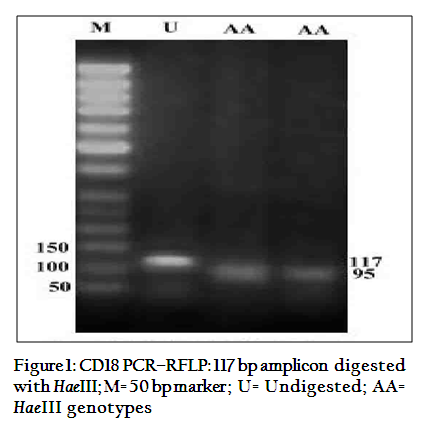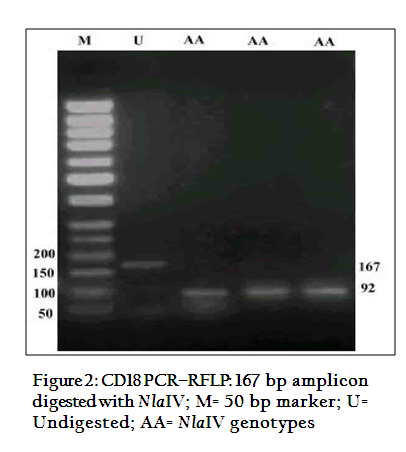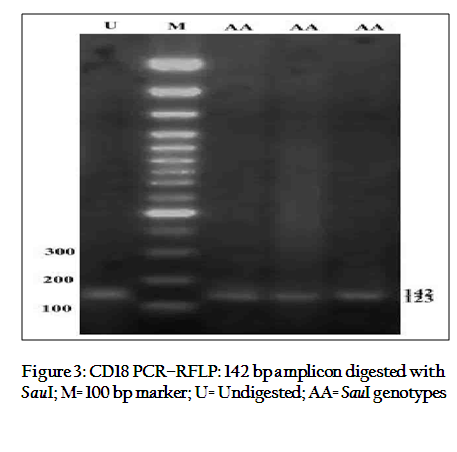Journal of Animal Health and Production
Short Communication
Journal of Animal Health and Production. 2 (1): 5 – 7PCR–RFLP Analysis of CD18 Gene in Buffalo
Deepak Sharma, Subodh Kumar*, Sitangsu Mohan Deb
*Corresponding author: subkum@gmail.com
ARTICLE CITATION:
Sharma D, Kumar S and Deb SM (2014). PCR–RFLP analysis of CD18 gene in buffalo. J Anim Health Prod. 2 (1): 5 – 7.
Received: 2014–01–31, Revised: 2014–02–11, Accepted: 2014–02–12
The electronic version of this article is the complete one and can be found online at
(
http://dx.doi.org/10.14737/journal.jahp/2014/2.1.5.7
)
which permits unrestricted use, distribution, and reproduction in any medium, provided the original work is properly cited
ABSTRACT
An attempt was made to ascertain polymorphism in three fragments of 117, 167 and 142 bp size, corresponding to exon 8, 10 and 13, respectively of CD18 gene in 45 water buffaloes (Bubalus bubalis) of Murrah breed. Upon digestion with HaeIII, NlaIV and SauI restriction enzymes, all DNA samples yielded similar fragments which indicated the absence of mutant allele. Results indicated that studied buffalo populations lack polymorphism in the CD18 genes.
Immune response and disease resistance traits are polygenic in nature and are controlled by many genes which can be classified as genes coding for pathogen receptors, genes regulating phagocytic function and major histocompatibility complex (MHC) genes group. The cell adhesion molecules play intricate function in recognition of inter cellular and cellular matrix communication. The beta 2 integrin (ITGB2), plays role in the regulation of leukocyte migration and adhesion specificity. The ITGB2 is a heterodimer comprising of CD18 and CD11 subunits (Arnaout, 1990). The cDNA sequence of bovine CD18 comprises of 2833 bp (Shuster et al., 1992) and is located on BTA1 in exotic cattle. This gene is also known to have many hotspots for mutations that are related to disease susceptibility. This gene is also known to cause obesity in mice and human (Awaya et al., 2008). However, the genomic sequence of this gene is partly known. The present study is an attempt to reveal polymorphism in exon 8, 10 and 13 of CD18 gene of water buffaloes (Bubalus bubalis), which is a major milch animal in India and south east Asia.
Genomic DNA was isolated from 45 buffaloes (Bubalis bubalis) of Murrah breed which were randomly selected from livestock farm of IVRI, Izatnagar. Fifteen ml of venous blood was collected from each animal in a sterile centrifuge tube containing 0.5 ml of 2.7% EDTA as anticoagulant. Isolation of genomic DNA was done as per the standard protocol (Sambrook and Russell, 2001). The purity, quality and quantity of DNA so obtained was checked. Three sets of primers (8F: GCA ATG TCA CCA GGC TGC TG; 10F: ACA GCC ACC GAG TGC ATC CA and 13F: GGT TCG GCA TGC CAG TGC as forward and 8R: GGT TGT CTT CCA GGT GGC AG; 10R: CAG CAG ACG CCG CAC TCC AT and 13R: CCG GGC ACT CGC TGC as reverse primers) were designed using the DNASTAR software, on the basis of genomic sequence of cattle (GenBank Accession No. M81233) to amplify the 117, 167 and 142 bp fragments corresponding to exon 8, 10 and 13 of CD18 gene, respectively. The PCR was carried out in a total volume of 50 µl containing 100 ng (3 µl) DNA, 5 µl of 10X PCR buffer (500 mM KCl, 100 mM Tris–HCl, pH 8.3), 0.2 mM (5 µl) of dNTP mix, 1.5 mM (3µl) MgCl2, 30 pM (1 µl) of each primer and 1.0 U (0.3 µl) Taq DNA polymerase. Samples were amplified for 35 cycles of 94˚C for 45 sec, 59˚C for 45 sec and 72˚C for 45 sec; followed by final extension at 72˚C for 5 min with initial denaturation at 94˚C for 3 min. The restriction enzymes, HaeIII (GG↓CC), NlaIV (GGN↓NCC) and SauI (CC↓TNAGG) were used to digest 117, 167 and 142 bp amplified fragment (amplicon), respectively. For genotyping and standardizations of PCR reactions, protocols were adapted from Geetha et al. (2011 and 2013). Ten µl of the PCR reaction mixture along with 2 µl of 10 X buffer was digested at 37˚C for overnight with 10 U of restriction enzyme. The digested restriction fragments were resolved in 2.5 % w/v agarose gel (Biogene, USA) stained with ethedium bromide in 1X TAE buffer, visualized in transilluminator and documented in gel doc system (Syngene, USA).
In the present study, three fragments of 117, 167 and 142 bp size, corresponding to exon 8, 10 and 13 of CD18 gene, were amplified using primer sets 8F/8R, 10F/10R and 13F/13R respectively. The 117 bp amplicon (corresponding to exon 8) upon digestion with HaeIII restriction enzyme revealed monomorphic pattern of 95 and 22 bp restriction fragments though the smaller fragment of 22 bp could not be resolved in the gel (Figure 1). The digestion of 167 bp amplicon (corresponding to exon 10) with NlaIV revealed 92 and 75 bp fragments though the smaller fragment of 75 bp could not be resolved in the gel in all the animal indicating absence of polymorphism (Figure 2).

Figure 1: CD18 PCR–RFLP: 117 bp amplicon digested with HaeIII; M= 50 bp marker; U= Undigested; AA= HaeIII genotypes

Figure 2: CD18 PCR–RFLP: 167 bp amplicon digested with NlaIV; M= 50 bp marker; U= Undigested; AA= NlaIV genotypes
The amplicon of 142 bp fragment (corresponding to exon 13) upon digestion with SauI again revealed a monomorphic pattern of 123 and 19 bp fragments wherein the smaller fragment of 19 bp could not be resolved in the gel (Figure 3). In the present study, the exon 8, 10 and 13 were found to be conserved as they did not exhibited variability. Earlier, Tamman et al. (1996), Czarnik and Kaminski (1997) and Kriegesmann et al. (1997) amplified 101, 367 and 344 bp fragment respectively, encompassing exon 5 of CD18 gene of exotic cattle and observed polymorphism. Czarnik et al. (2004, 2007) have also observed polymorphism using Fnu4HI restriction enzyme in exotic cattle. This indicated that buffaloes had negligible or very rare variation as compared to cattle. All the 45 samples showed similar type of band pattern hence no polymorphism was found with respect to any of these restriction enzymes and accordingly the gene and genotype frequencies in all the cases were 1.00. On the other hand, a fragment corresponding to exon 5 and 6 exhibited polymorphism in Murrah buffalo with respect to MspI restriction enzyme (Sharma et al., 2009, 2010) exhibiting two alleles but failed to detect polymorphism when digested with HaeIII, TaqI, SauI and Hin1I restriction enzymes. Though the PCR–RFLP technique is also not sensitive to differentiate between two alleles if the mutation does not exist within the restriction frame hence tends to yield a monomorphic pattern of genotypes however Kumar et al. (2011) were successful in finding polymorphism in SLC11A1 gene in cattle using AluI and TaqI restriction enzymes.

Figure 3: CD18 PCR–RFLP: 142 bp amplicon digested with SauI; M= 100 bp marker; U= Undigested; AA= SauI genotypes
Further, if any polymorphism in these genes is identified in future, then association of these polymorphs with disease resistance/tolerance/immune responses traits viz. differential leukocyte count, in vitro hydrogen proxide, in vitro nitric oxide production etc. could be used as a genetic marker for selection programme. More number of individuals belonging to different breeds should also be screened with more number of restriction enzymes to find out the allelic variants in other exonic and intronic regions of this gene. Attempts should also be made at studying the polymorphism of other immune response genes.
ACKNOWLEDGEMENTS
The authors would like to thank the Director, IVRI, Izatnagar and Department of Biotechnology (DBT), Govt. of India, for providing financial support and infrastructure.
REFERENCES
Arnaout MA (1990). Structure and function of leukocyte adhesion molecules CD11 CD18. Blood. 75: 1037–1050.
PMid:1968349
Awaya T, Yokosaki Y, Yamane K, Usui H, Kohno N and Eboshida A (2008). Gene–environment association of an ITGB2 sequence variant with obesity in ethnic Japanese. Obesity. 16: 1463–1466.
http://dx.doi.org/10.1038/oby.2008.68
PMid:18369341
Czarnik U, Galinski M, Zabolewicz T and Pareek CS (2007). Study of SNP 775C>T. polymorphism within the bovine ITGB2 gene in polish black and white cattle and in local breeds of cattle. Czech. J. Anim. Sci. 52: 57–61.
Czarnik U and Kaminski S (1997). Detection of intronic sequence in the bovine ITGB2 gene. Anim. Genet. 28: 308–322.
Czarnik U, Zabolewicz T, Galinski M, Pareek CS and Walawski K (2004). Silent point mutation polymorphism of the bovine CD18 encoding gene. J. App. Genet. 45(1): 73–76.
PMid:14960769
Geetha T, Kumar S, Dubey PP, Sivamani B, Ghosh SK, Mitra A, Tomar AKS and Sharma A (2011). Sequence variability in CatSper1 gene in Vrindavani crossbred cattle. Ind. J. Anim. Sci. 81 (9): 981–983.
Geetha T, Kumar S, Dubey PP, Sivamani B, and Sharma A (2013). Polymorphism in Catsper1 gene in crossbred (Bos taurus x Bos indicus) cattle. Adv.Anim. Vet. Sci. 1 (4): 123–126.
Kriegesmann B, Jansen S, Bahmgartner BG and Brenig B (1997). Partial genomic structure of bovine CD18 gene and refinement of test for bovine leukocyte adhesion deficiency. J. Dairy Sci. 80: 2547–2549.
http://dx.doi.org/10.3168/jds.S0022-0302(97)76209-X
Kumar N, Ganguly I, Singh R, Deb SM, Kumar S, Sharma A and Mitra A (2011). DNA Polymorphism in SLC11A1 Gene and its Association with Brucellosis Resistance in Indian Zebu (Bos indicus) and Crossbred (Bos indicus×Bos taurus) Cattle. Asian–Aust. J. Anim. Sci., 24 (7): 898 – 904.
Sambrook J and Russel D (2001). Molecular cloning: A Laboratory Manual. 2nd edn, Vol. III, pp. 6.3–6.4, Cold Spring Harbour Laboratory Press.
Sharma D, Kumar S, Deb SM, Mitra A, Niranjan SK, Naskar S and Sharma A (2009). Identification of Novel Allelic Variants of Integrin Beta 2 (ITGB2) Gene and Screening for Bubaline Leukocyte Adhesion Deficiency Syndrome in Indian Water Buffaloes (Bubalus bubalis). Anim. Biotechnol. 20 (3): 156 – 160.
http://dx.doi.org/10.1080/10495390902895883
PMid:19544212
Sharma D, Niranjan SK, Kumar S, Deb SM, Naskar S, Sharma A and Mitra A (2010). Molecular characterization of bubaline integrin β2 (ITGB2) cDNA. J. Appl. Anim. Res. 37: 217–220.
http://dx.doi.org/10.1080/09712119.2010.9707127
Shuster DE, Bosworth BT and Kehrli M E Jr (1992). Sequence of the bovine CD18 encoding cDNA. Comparison with human and murine glycoproteins. Gene. 114: 267–271.
http://dx.doi.org/10.1016/0378-1119(92)90586-E
Tamman HK, Kuczka A, Treivranus A, Pohlenj J, Stober M and Simon D (1996). An improved DNA test for bovine leukocyte adhesion deficiency. Res. Vet. Sci. 60: 218–221.
http://dx.doi.org/10.1016/S0034-5288(96)90042-9




